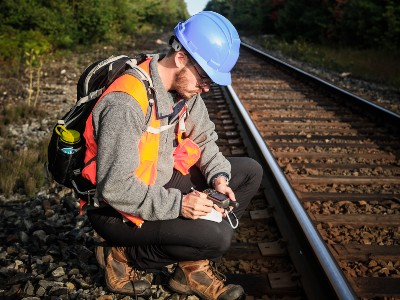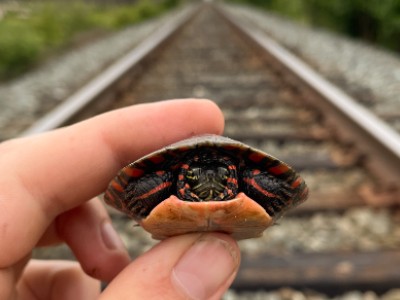When the first true railway in Canada was opened in 1836, no one had really stopped to consider just how much trains would impact wildlife.
Nearly 200 years later, we are working to better understand this significant impact.
Kyle Vincent is part of a group from Laurentian University undertaking an unprecedented study of railway impact on ecology. One of the things that makes this study so groundbreaking is that it originated from conversations between members of Shawanaga First Nation, Magnetawan First Nation and Dr. Jesse Popp, a Canada Research Chair in Indigenous Environmental Science at the University of Guelph, and an Adjunct Professor at Laurentian University.

The fact that the study was initiated by the First Nations communities is a large part of what drew Kyle to the project.
“Part of the methodology we used was interviewing members of both communities to learn about their concerns and observations around railway and wildlife interactions,” says Kyle. “We paired that Indigenous knowledge with Western science approaches like surveys and the deployment of trail cameras to better understand how wildlife interact with railways, based on the concerns from community members.”
“That’s really the fundamental aspect of this project: drawing on the strengths of both knowledge systems, Indigenous knowledge and western science, in a respectful and responsible way.”
After having done his undergrad in biology at Nipissing University in North Bay, Ontario, the call of Northern Ontario nature drew him to the Laurentian campus, as did the opportunity to work with both Dr. Popp and Dr. Jacqueline Litzgus, Professor of Science, Engineering and Architecture at Laurentian.
“Dr. Litzgus is a very well-respected academic in the turtle ecology world,” explains Kyle, who has always been drawn to species at risk – especially turtles. “Here in Ontario, all eight species of turtle we have are currently listed as species at risk, either federally or provincially. Both amphibians and reptiles are among the taxonomic groups facing the most threats worldwide.”
“So, they’re already facing all these other threats from things like habitat loss and road mortality. We really want to know if railways are putting added pressures on these populations.”

The project found 87% of wildlife railway mortalities tend to consist of reptiles and amphibians such as frogs and turtles - many of whom are considered at-risk species. That’s significant… and a number that wouldn’t have come to light without the collaboration between the First Nation Communities, Laurentian University, the University of Guelph, and the railways themselves.
But not being Indigenous himself, Kyle has also discovered the strengths of looking at the world through the lenses of both Indigenous perspectives and Western science.
“I come from a Western science biology background where you’re trained to think about things in a certain way and use the scientific method,” says Kyle. “This project really opened my eyes to the value of other knowledge systems and looking at things in ways that I never would have thought of before.”
“That’s something that I’m going to carry with me, because of the opportunity to work with the First Nation Communities and the influence of my Laurentian supervisors.”
Kyle Vincent’s Thesis is titled, “WEAVING INDIGENOUS KNOWLEDGE AND WESTERN SCIENCE TO INVESTIGATE THE IMPACTS OF RAILWAYS ON WILDLIFE” and has already been recognized at the LU Graduate Research Symposium.